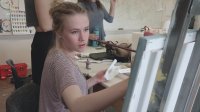Creativity and Academics: The Power of an Arts Education
Increased self-confidence and self-understanding, enhanced communication skills, and improved cognition are among the many reasons for teaching the arts.
The arts are as important as academics, and they should be treated that way in school curriculum. This is what we believe and practice at New Mexico School for the Arts (NMSA). While the positive impact of the arts on academic achievement is worthwhile in itself, it's also the tip of the iceberg when looking at the whole child. Learning art goes beyond creating more successful students. We believe that it creates more successful human beings.
NMSA is built upon a dual arts and academic curriculum. Our teachers, students, and families all hold the belief that both arts and academics are equally important. Our goal is to prepare students for professional careers in the arts, while also equipping them with the skills and content knowledge necessary to succeed in college. From our personal experience (and research), here are five benefits of an arts education:
1. Growth Mindset
Through the arts, students develop skills like resilience, grit, and a growth mindset to help them master their craft, do well academically, and succeed in life after high school. (See Embracing Failure: Building a Growth Mindset Through the Arts and Mastering Self-Assessment: Deepening Independent Learning Through the Arts.) Ideally, this progression will happen naturally, but often it can be aided by the teacher. By setting clear expectations and goals for students and then drawing the correlation between the work done and the results, students can begin to shift their motivation, resulting in a much healthier and more sustainable learning environment.
For students to truly grow and progress, there has to be a point when intrinsic motivation comes into balance with extrinsic motivation. In the early stages of learning an art form, students engage with the activity because it's fun (intrinsic motivation). However, this motivation will allow them to progress only so far, and then their development begins to slow -- or even stop. At this point, lean on extrinsic motivation to continue your students' growth. This can take the form of auditions, tests, or other assessments. Like the impact of early intrinsic motivation, this kind of engagement will help your students grow and progress. While both types of motivation are helpful and productive, a hybrid of the two is most successful. Your students will study or practice not only for the external rewards, but also because of the self-enjoyment or satisfaction this gives them.
2. Self-Confidence
A number of years ago, I had a student enter my band program who would not speak. When asked a question, she would simply look at me. She loved being in band, but she would not play. I wondered why she would choose to join an activity while refusing to actually do the activity. Slowly, through encouragement from her peers and myself, a wonderful young person came out from under her insecurities and began to play. And as she learned her instrument, I watched her transform into not only a self-confident young lady and an accomplished musician, but also a student leader. Through the act of making music, she overcame her insecurities and found her voice and place in life.
3. Improved Cognition
Research connects learning music to improved "verbal memory, second language pronunciation accuracy, reading ability, and executive functions" in youth (Frontiers in Neuroscience). By immersing students in arts education, you draw them into an incredibly complex and multifaceted endeavor that combines many subject matters (like mathematics, history, language, and science) while being uniquely tied to culture.
For example, in order for a student to play in tune, he must have a scientific understanding of sound waves and other musical acoustics principles. Likewise, for a student to give an inspired performance of Shakespeare, she must understand social, cultural, and historical events of the time. The arts are valuable not only as stand-alone subject matter, but also as the perfect link between all subject matters -- and a great delivery system for these concepts, as well. You can see this in the correlation between drawing and geometry, or between meter and time signatures and math concepts such as fractions.
4. Communication
One can make an argument that communication may be the single most important aspect of existence. Our world is built through communication. Students learn a multitude of communication skills by studying the arts. Through the very process of being in a music ensemble, they must learn to verbally, physically, and emotionally communicate with their peers, conductor, and audience. Likewise, a cast member must not only communicate the spoken word to an audience, but also the more intangible underlying emotions of the script. The arts are a mode of expression that transforms thoughts and emotions into a unique form of communication -- art itself.
5. Deepening Cultural and Self-Understanding
While many find the value of arts education to be the ways in which it impacts student learning, I feel the learning of art is itself a worthwhile endeavor. A culture without art isn’t possible. Art is at the very core of our identity as humans. I feel that the greatest gift we can give students -- and humanity -- is an understanding, appreciation, and ability to create art.
What are some of the benefits of an arts education that you have noticed with your students?
New Mexico School for the Arts
Enrollment
222 | Charter, SuburbanPer Pupil Expenditures
$9992 District • $9734 StateFree / Reduced Lunch
20%DEMOGRAPHICS:
This post is part of our Schools That Work series, which features key practices from New Mexico School for the Arts.
